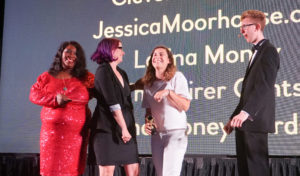Joseph Hogue worked as an equity analyst and an economist before realizing being rich is no substitute for being happy. He now runs five websites and a YouTube channel in the personal finance niche, makes more money than he ever did at a 9-to-5 job and loves building his work-from-home business. Visit the channel on YouTube and join the community.
It was during FinCon 2017 that I realized the writing was on the wall. Publishers and vendors alike were planning their transition to video. Creators without some influence in video marketing risked being shut out of sponsorships and other benefits.
I’ve had my YouTube Channel, Let’s Talk Money, since 2005 but never used it as an organic platform. It was always just a place to host two-minute summary videos of posts that I could embed on my blogs.
When I did start creating video content for the channel, I quickly realized just how frustrating and time-consuming the platform could be. I was spending three to five hours on each video and seeing my subscriber numbers barely tick higher.
Through more than a few hours of studying what makes a video successful on YouTube and a lot of testing, I’ve been able to get that time down to about two hours per video and have seen my subscriber count jump.
What has helped me cut hours from video production and sparked channel growth? Video structuring and a simple checklist of video elements.
I restarted the channel on December 25 last year (because what else was I going to do) with just 21 subscribers. In less than eight months, the channel has grown to 9,300 subscribers with an average of over 1,000 views per video. It’s already contributed to two huge sponsorship deals and looks like it will make YouTube a significant part of my business going forward.
Below I’ll share the thinking behind the video structure I use as well as my checklist for driving engagement.
Hook YouTube Viewers with a HOT Lead
Most videos lose between 15% and 25% of their audience within the first half minute of the video. That’s a huge amount of missed watch-time and hooking as many of your viewers as quickly as possible is one of the most important things you can do.
The best way to do this is a technique called the HOT lead I picked up from Sunny Lenarduzzi, a YouTube expert on the platform.
The HOT lead is a 15- to 25-second intro to your video that hooks viewers by telling them they’re in the right place and building credibility for the content.
- Hook is one sentence that grabs the viewer’s attention, mentioning the problem or pain point they are looking to address
- Outcome is a sentence telling the viewer exactly what they’ll get by watching the video, i.e. “By the end of this video, you’ll have a three-step system…”
- Testimonial validates the content with a one-sentence confirmation of how the information changed someone’s life, i.e. “In fact, I used this system to…”
Hooking your audience early like this will not only get them excited to watch the entire video but gives the video a little more organization versus just jumping into the content. That’s going to make your videos look more professional and boost your subscriptions.
Building a Community through Your Brand
Brand building is arguably the Holy Grail of YouTube and really any publishing platform. Building a community around your brand will create a base of followers that will come back to your channel for every video. They’ll engage through comments and be enthusiastic cheerleaders for your business.
I try to start every video, after the lead, by thanking people in the channel’s community for taking their time to watch. I have a few slogans I use regularly with the channel like, “creating the financial future you deserve,” that not only tell viewers what the channel is about but also help to create that sense of purpose.
As a transition into the actual content of the video, I try to share a personal or emotional story that relates to the problem that brought viewers to the video. Within this story, there are other brand-building concepts you can use to grow your community.
- Creation story – Every great super hero needs a creation story, where you come from and what led you to help people with your videos. Help people see that you’re more than just a five-minute video.
- Shared beliefs are the purpose and values that will bind your community. Communicate these through slogans and quotes you can use regularly.
- Leaders and Icons are historic figures or objects that embody the community’s shared beliefs. You build your brand by associating it with these leaders and icons.
For example, while videos on my channel revolve around financial topics, I try to represent shared beliefs of national pride and hope. My video background includes a picture of the Statue of Liberty, a couple of WWII-era Coca-Cola ads and my Marine Corps shadow box. Within the introduction, I try to relate the content to something I learned in the military or from an historic figure.
Finally, I always ask viewers to become a part of the community within the first minute or two of the video. Most people still see YouTube as a source for occasional answers to a question or single-serving videos. Let them know that it’s more, that your channel is a community of people that are driving to a shared goal.
How to Keep YouTube Viewers on Your Video
Video platform Wistia found that, on average, less than 35% of the audience sticks around to see the end of a 5- to 10-minute video. That retention rate isn’t much better on shorter clips with less than half the viewers watching a full two-minute video.
But keeping people watching your video is how you build up Watch-Time, the single most important metric in YouTube’s algorithm that ranks videos.
Studying some of the retention graphs on my videos, I noticed an interesting point. Retention flattens out whenever a graphic or some other interrupt brings the viewers’ attention back to the video.
Keeping people watching your videos means giving them something more to look at than just your pretty face. Any time you can interrupt the monotony of a talking head video with a graphic, text or even a sound effect, you’ll draw attention back to the video and keep people interested.
I use four types of graphic interrupts regularly, aiming for at least one every 30 – 45 seconds.
- Corner box – this is just a small image in one of the top corners of the video. This is a favorite used during news broadcasts because it keeps focus on the presenter but breaks up the flow a little.
- Full screen graphic – this is a cut away to a full screen graphic or image. Generic ‘b-roll’ images will work but try to provide a chart or table that helps explain the content.
- Full screen bullet list is an easy way to summarize the content and re-engage viewers.
- Text overlay can be as simple as text appearing somewhere on the video or you can spice it up with sound effects and animation.
YouTube Success is about the Little Things
Beyond the general structure of your video, there are a lot of little things that will help drive engagement from viewers and keep them watching more of your channel.
- Ask a specific question during the video, something that makes it easier for people to leave a comment. Engagement is hugely important in the YouTube algorithm and getting as many comments as possible will help boost your video.
- Tease some kind of ‘bonus’ content that comes toward the end of the video whether it’s extra information or related material, anything to excite viewers and keep them watching.
- Include humor through images and jokes…even if you’re not funny. Just because you’re sharing financial content doesn’t mean it can’t be entertaining as well.
- Don’t use summary or ‘wrapping up’ language towards the end of the video. This cues viewers that the video is over and retention plummets. Instead, keep providing valuable content all the way through to your end screen and final call-to-action.
Unless you come from a broadcasting or entertainment background, remembering all the details to include in each video can seem overwhelming. It becomes more natural after a while, but I still use a checklist while scripting each video.
This makes it easier…and less stressful, knowing that I’ve ticked every box to make my videos as successful as possible. I also have copied a boiler plate section that I paste at the bottom of every video description.
Launching a channel on YouTube can be frustrating but it’s a great platform to drive traffic to your blog and create another source to market for sponsorships. Like ranking on Google, a lot of your success depends on checking all the boxes and doing what you can to engage viewers and keep them watching.















1 Comment
Nate Peterson · August 27, 2018 at 5:54 pm
Great information! I will be implementing the 3 step outline structure in my instructional videos immediately.